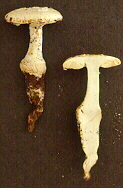|
[ Amanita rhoadsii var. flavotingens Bas ]
[ Section Lepidella page. ]
[ Amanita Studies home. ]
[ Keys & Checklist/Picturebooks ] "Rhoads' Lepidella"
Technical description (t.b.d.) BRIEF DESCRIPTION: Amanita rhoadsii has very narrow spores, which commonly may be more than 4 times as long as they are wide. The cap is white and 50 - 100 mm wide. The gills are white to cream to yellowish cream, adnate or adnexed, and moderately crowded to crowded. The short gills are subtruncate to attenuate. The exannulate stipe is 70 - 180 x 7 - 20 mm and, at first, densely floccose; at the stipe base is an elongate bulb. There are rarely any volval remnants at the top of the stipe's basal bulb. Amanita rhoadsii has a distinctive odor (some authors call it "old ham"), not of chlorine, but quite difficult to describe. A yellow-staining var. (A. rhoadsii var. flavotingens Bas) has been described. The spores measure (9.8-) 10.1 - 14.5 (-15.5) x (3.5-) 3.8 - 4.8 µm and are cylindric to bacilliform (even, infrequently, more than four times longer than wide!) and amyloid. Clamps are present on bases of basidia. Because, the closely related A. subsolitaria (Murrill) Murrill is occasionally found strongly staining yellow and obviously parasitized by something, it would be a worthwhile project to find yellow-staining A. rhoadsii and examine them for an environmental cause of the reaction. The yellow staining members of A. rhoadsii were placed in A. rhoadsii var. flavotingens Bas. Amanita rhoadsii and A. subsolitaria make up Bas' stirps Rhoadsii. Amanita rhoadsii is often associated with oak and pine. Amanita rhoadsii is moderately common in the southern part of the sandy
Atlantic coastal plain of the U.S. and along the U.S. Gulf Coast. A. subsolitaria has an overlapping
range, and has been collected as far north as Cape Cod. Photos: L. R. Hesler (top, Florida, with permission of Dr. R. H. Petersen, Curator, L. R. Hesler Herbarium, Univ. of Tenn., Knoxville); R. E. Tulloss (bottom, Mississippi) [ top ] Amanita rhoadsii var. flavotingens Bas The following description is based on the original description by Bas (1969). The cap of Amanita rhoadsii var. flavotingens is 65 mm wide, plano-convex, white, turning yellow when bruised, dry, with a nonstriate margin. The cap is completely covered with a powdery-somewhat finely fibrillose volval layer, sometimes with fluffy, floccose, small warts sometimes near the center. The flesh is white and turning yellow when cut. The gills are crowded, touch the stem, rather narrow, white, yellow when bruised. The short gills are attenuate. The stem is 80 × 10 mm, solid, white, yellow where bruised, covered with floccose material, lacking a ring, cylindric. The bulb is elongate-radish-like and 40 × 25 mm. The volva is present as some vague, friable fragments on the top of the bulb. The flesh is white, turning yellow when cut, at length turning reddish brown. The taste is mild. The odor is slightly pungent but not of decaying protein ("chloride of lime"). The spores measure 10 - 12 × 3.5 - 4.5 µm and are cylindric to bacilliform, slightly yellowish, and amyloid. Clamps are present at bases of basidia. This species was originally collected from Florida (USA). The tree association is unknown. Among the differences from the type variety are the yellowing reaction, the strong gelatinization of the cap surface including cap flesh below the volval remnants, the alteration of the odor, the spores are shorter, and the length to breadth ratio is not reported to exceed 3.2. RET questions the taxonomic value of this variety because the yellow staining (with the eventual transition to red-brown in the stem) suggests the "yellowing syndrome" seen in other species of section Lepidella in Eastern North America. The unusual degree of gelatinization (decay?) of the cap and the reduction in size of spores are other characteristics that suggest this specimen was diseased. For more notes on the "yellowing syndrome" see A. subsolitaria (Murrill) Murrill. -- R. E. Tulloss and L. Possiel [ top ]
[ Section Lepidella page. ]
[ Amanita Studies home. ]
[ Keys & Checklist/Picturebooks ] Last changed 19 March 2009. |


